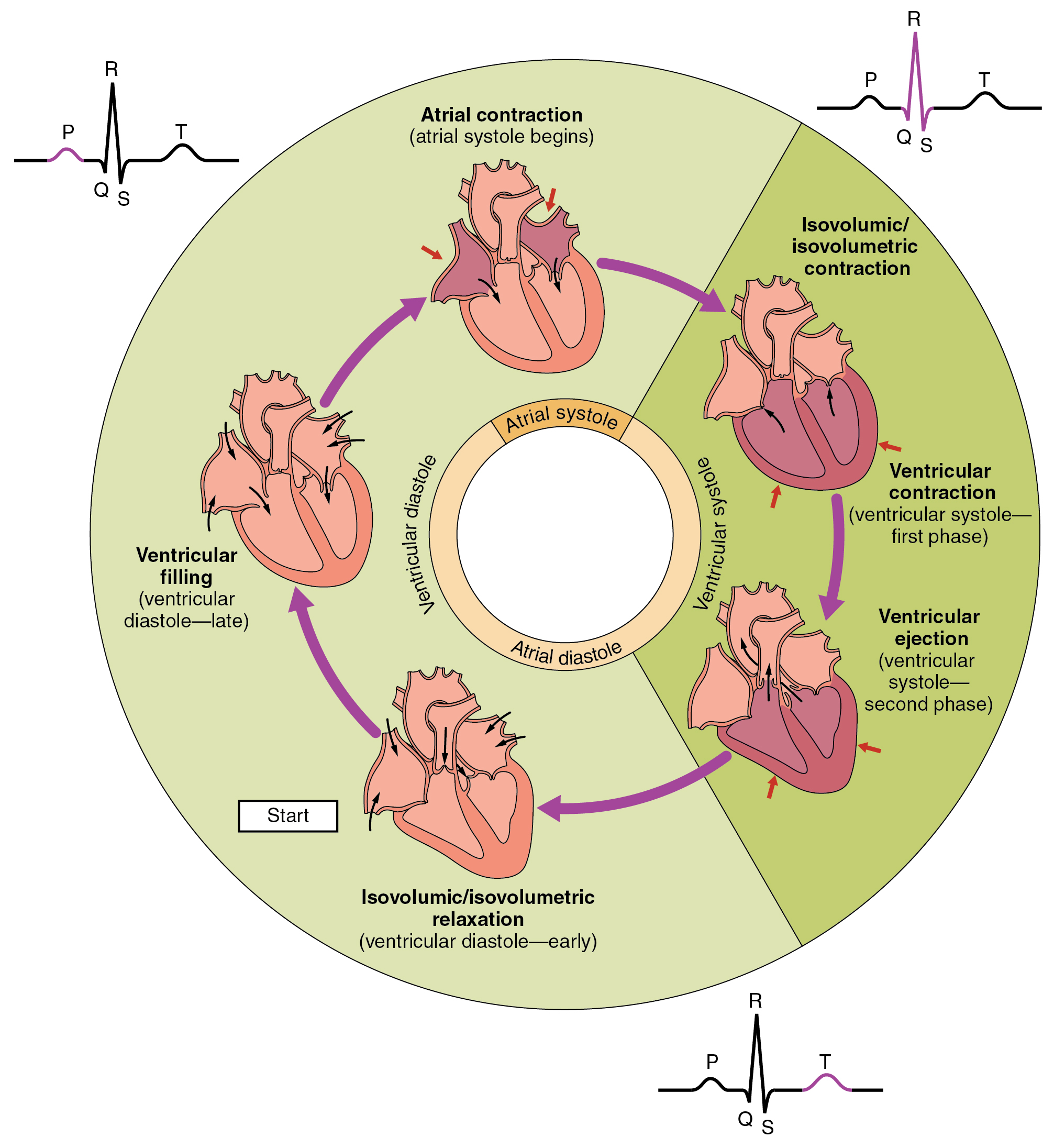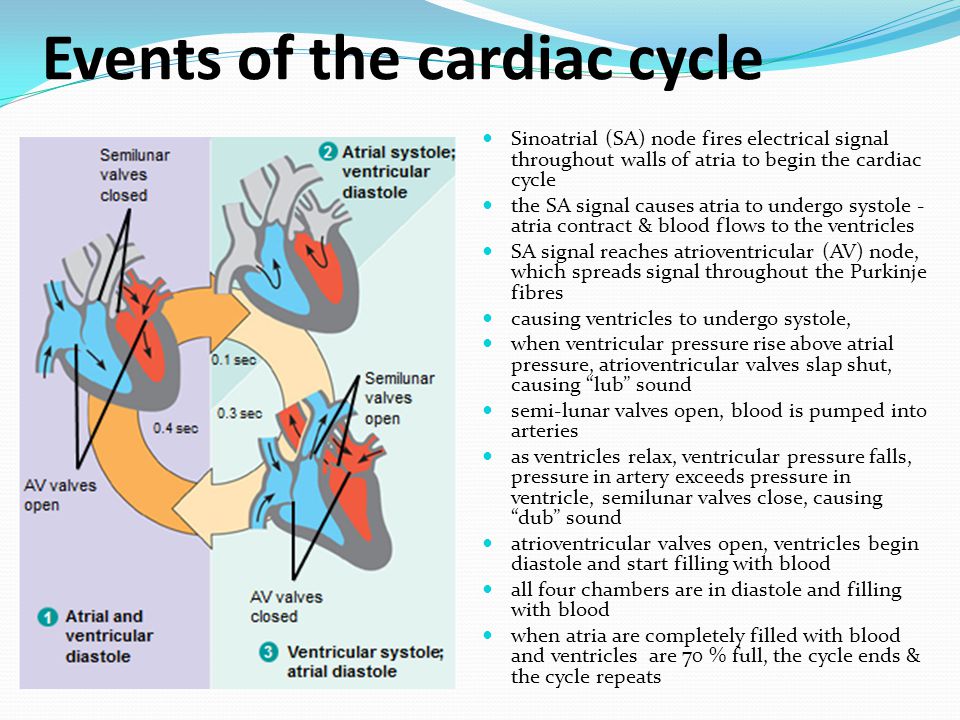Describe the Events That Make Up the Cardiac Cycle
47-4 as well as electrical activity as represented by the ECGWhen the heart muscle is relaxed at end. Four phases of the cardiac cycle.

The Cardiac Cycle Pressures In The Heart Teachmephysiology
In the diastole phase heart ventricles relax and the heart fills with blood.

. Diastole represents ventricular filling and systole represents ventricular contractionejection. In resting humans the heart beats approximately once per second. The atria contract at the same time forcing blood through the atrioventricular valves into the ventricles.
The period of contraction that the heart undergoes while it pumps blood into circulation is called systole. Mechanical events of the cardiac cycle 1Atrial systole. It is initiated by spontaneous generation of action potential in SA sinoatrial node.
As the heart beats it circulates blood through pulmonary and systemic circuits of the body. The eight-tenths of a second that a heart beats is called the cardiac cycle. During the heart beat there is a contraction and relaxation of atria and ventricles.
Systole and diastole occur in both the right and left heart though with very different pressures see. The semilunar valves - aortic and pulmonary - are situated at bases of large arteries preventing regurgitation of blood into the ventricles during the cardiac diastole. There are 2 main phases to the heart cycle - diastole and systole.
Period of ventricular contraction and blood ejection 2 Diastole. Following events take place in a cardiac cycle. The cardiac cycle consist of one heart beat or one cycle of contraction and relaxation ie takes place in the cardiac muscles.
The events of the cardiac cycle start with a spontaneous action potential in the sinus node as we described previously. The ventricular diastolic stage involves blood flow from the atria to the ventricles and the ventricular systole includes blood flow from the ventricles to the pulmonary artery and the aorta. The period of contraction that the heart undergoes while it pumps blood into circulation is called systole.
Both the atria and ventricles undergo systole and diastole and it. The successive events of the cardiac cycle are briefly described as below. Diastole when the heart fills with blood and systole when the heart pumps the blood.
The relaxed heart allows for blood to fill the cardiac chambers. The pureblood is again collected in the heart which once again is pumped to different parts muscle cells and tissues of our body. The cardiac cycle is the sequence of events that occurs when the heart beats.
There are two phases of the cardiac cycle. The contraction of the heart muscles called systole and the relaxation period known as diastole. Consists of 2 phases.
It beats continually every 08 seconds of your life. The period of time that begins with contraction of the atria and ends with ventricular relaxation is known as the cardiac cycle. The cardiac cycle attributes to a comprehensive heartbeat from its production to the commencement of the next beat.
This is followed by a relaxation phase diastole where the heart fills with blood as illustrated in Figure 1. Cardiac cycle is the term referring to all of the events that occurs from the beginning of one heartbeat to the beginning of the next. When the tricuspid and bicuspid valves open blood from pulmonary veins and vena cava flows respectively Into the left and right auricles.
The cardiac cycle The cardiac cycle refers to the pattern of contraction and relaxation of the heart during one complete heartbeat. Between the left ventricle and aorta. The cardiac cycle comprises a complete relaxation and contraction of both the atria and ventricles and lasts approximately 08 seconds.
Ventricular filling occur during diastole. The inlet valve is open and the outlet valve is closed. The cardiac cycle The cardiac events occur from the beginning of one heart beat to the beginning of next heart beat.
It comprises diastole the systole and the intervening pause. The frequency of the cardiac cycle is the heart rate. The diastole phase and the systole phase.
With each beat the heart cycles through a series of four hemodynamic events represented by changes in pressures and volumes E-Fig. Some events of cardiac cycle are as follows. Systole and diastole occur through a series of events marked by structural changes of the cardiac chambers the atria and ventricles.
The period of time that begins with contraction of the atria and ends with ventricular relaxation is known as the cardiac cycle. Cardiac cycle refers to the sequence of events that take place when the heart beats What is Cardiac Cycle. Systole is defined as the phase in which the heart especially the ventricles is contracting.
Cardiac cycle The cardiac cycle separates into two major phases the ventricular systole and the ventricular diastole which include the atrial systole. The contraction phase is referred as systole while the relaxation phase is called as diastole. Generally the cardiac cycle can be divided into two separate periods.
Beginning with all chambers in diastole blood flows passively from the veins into the atria and. At the beginning of a cardiac cycle all the four chambers of heart is in diastole. All these events are organized in two phases.
All these series of events happens smoothly in a cycle and is known as cardiac cycle. These events result in changes in pressure flow and volume in the various cardiac chambers. Lee Goldman MD in Goldman-Cecil Medicine 2020.
The sequential events in a heart-beat comprise the cardiac cycle. Contraction of the heart muscle is known as systole and. The time taken to complete one cardiac cycle is 08 sec and is called cardiac cycle time.
Duration of one cardiac cycle is O8 seconds. Diastole is defined as the phase in which the heart especially the ventricles is at rest. The period of relaxation that occurs as the chambers fill with blood is called diastole.
The period of relaxation that occurs as the chambers fill with blood is called diastole. This stimulus causes a series of events in the atria and the ventricles. The sequence of electrical and mechanical events occurring in the heart during a single beat.
Period of ventricular relaxation and filling. During that 08-second period your heart forces blood into your blood vessels for 04 seconds and then takes a quick rest for just 04 seconds. The cardiac cycle is a series of electrical and mechanical events that occur during the phases of heart relaxation diastole and contraction systole.
Cardiac cycle events can be divided into diastole and systole. In each cardiac cycle the heart contracts systole pushing out the blood and pumping it through the body.

Solved Cardiac Cycle Can You Walk Your Way Through The Chegg Com

Assessment Statements H 5 1 Explain The Events Of The Cardiac Cycle Including Atrial And Ventricular Systole And Diastole And Heart Sounds H 5 2 Analyse Ppt Download


Comments
Post a Comment